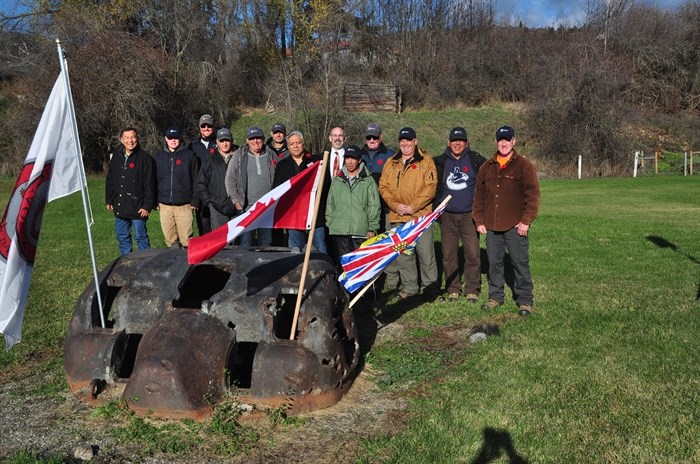
Members of the Okanagan Indian Band alongside employees of the Department of National Defence at a ceremony Nov. 11, 2015. The turret pictured in the photo was recovered during one of the UXO digs and relocated.
Image Credit: Contirbuted/Lisa Hampson
January 21, 2016 - 1:02 PM
VERNON - The Department of National Defence is responding to criticism from a local First Nation about the issue of removing military explosives from former training grounds.
The Okanagan Indian Band called out the Defence Department for failing to remove unexploded ordnances — mortars, artillery shells, grenades and small arms ammunition referred to as UXO’s — from land it leased from the band in the 1950s. While acknowledging some work has been done by the Defence Department, the band says clearance efforts are underfunded and taking too long to complete.
Lisa Hampson, a senior project manager with the department’s legacy site project admits UXO removal is a large and challenging undertaking for several reasons.
“I would argue the limiting factors almost come down to field seasons — how many weeks my guys can actually work — as well as capacity issues. There are only a fixed number of firms and a fixed number of technicians able to work in the field. There’s only so many human resources you can throw at this,” Hampson says.
The department has committed to giving the band $125,000 annually for the next four years, which pays for a liaison officer and skills training for band members to become certified in UXO clearance, Hampson says. On top of that, the department spent just over $1 million in 2014/2015 for actual clearance work, and has allocated another $1.6 million for UXO removal in 2016. With millions already being spent on clearance efforts, Hampson says more money isn’t necessarily the answer to the band’s concerns.
“It’s not as simple as putting money at it,” Hampson says. “The physical process takes so much time and we want to do it right. If we don’t, we have to do it again and again.”
Clearing a contaminated site involves reviewing historical data to find out what ammunitions were used during training, conducting field surveys, and physically digging out items by hand. The work can only be done once the ground thaws and is a slow, painstaking job, Hampson says.
The department was also criticized for asking the band for an economic development plan and timelines before initiating clearances, but Hampson says that’s how they identify priorities and know what level of clearance is required. The department clears to a depth of about 45 centimetres for agricultural use, but goes deeper if the future use is something like commercial development, Hampson says.
“At the end of the day, I’m a public servant and am here to serve the public’s, and the band’s, best interests,” Hampson says. “Why would I clear to a two metre depth and spend many more dollars if it’s going to be used as agricultural land?”
The band has said the presence of UXO on the land is scaring away investors and inhibiting development plans, however Hampson says it shouldn’t be standing in the way because it’s DND, not the band, that’s legally responsible if a UXO turns up.
“We have always said, if something is found, it’s the department’s responsibility to deal with it, there are fall back places there,” she says. “The deal is, if you find something, call 911, move away from the area. DND takes responsibility for the item that is found.”
She insists knowing how the band plans to use the land will help move the clearance work forward and says the department is eager to work with the band, which it respects greatly for its contributions to national defence.
“The key to the exercise is bridging the dialogue gap and having them effectively articulate what they need done, and it can’t be ‘clear everything all the time.’”
To contact a reporter for this story, email Charlotte Helston at chelston@infonews.ca or call 250-309-5230. To contact the editor, email mjones@infonews.ca or call 250-718-2724.
News from © iNFOnews, 2016